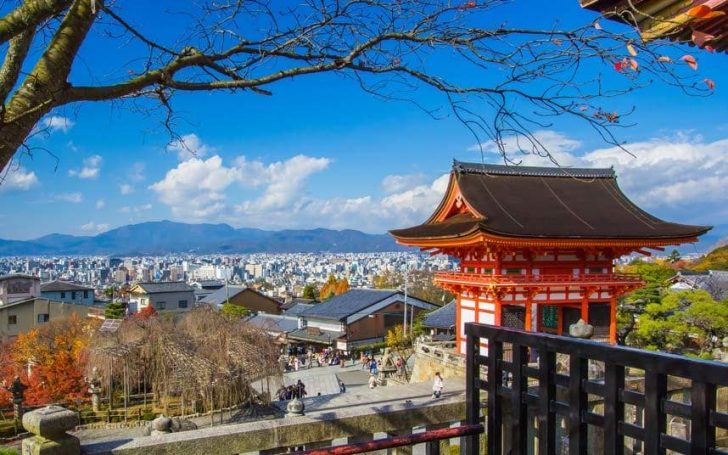Kyoto is a Japanese city, most notably renowned for its beautiful blossoming gardens of tranquillity, lesser known as the once imperial capital of the country. Due to its rich historical relevance, Kyoto has many important and culturally regarded landmarks and attractions, with iconic architecture and traditional re-enactments saturating this utterly delightful metropolis.
So, you know a little about the place, and what to expect, but when is the best time to visit Kyoto for those with an urge to get fully involved and feel what the locals feel? We’re here to help you decide, outlining what to do, and when to do it, below.
Festivals
Kyoto’s festivals are some of the most visually spectacular, traditionally relevant, and locally important in the world. There are many festivals throughout the year that are particularly well regarded with the inhabitants of the city, but the two most traditional include the Aoi Matsuri and Gion Matsuri.
Aoi Matsuri
Dating back to the 6th century, Aoi Matsuri is primarily a religious festival, with its origins in performing offerings to appease the nation’s gods in return for a successful harvest for the spring and summer ahead.
Contemporarily, the festival still incorporates many traditional elements, and is held on 15th May annually at the Kamo shrines , Kamigamo and Shimogamo.
In the run up to 15th May there are numerous events taking place, which lead up to two ultimate parades where residents dress in traditional attire; the Imperial Messenger’s parade, made up of noblemen and military men, and the Imperial Princess’ parade, incorporating noblewomen and other high-society females.
Gion Matsuri
Throughout July each year Kyoto hosts the Gion Matsuri, a festival which has origins in the 9th century, apparently to appease the gods in order to cleanse the city of a plague.
It later turned into an annual event in which the local merchants could display their wealth and precious foreign collections to their neighbours and any other passers by.
The festival has recently been reformed to associate itself as closely as possible with its original form, with processions of dancers and lantern lighting beginning at the start of the month, and various purifications and other events continuing until the final purification at the end of the month.
Other festivals around the year in Kyoto include Jidai Matsuri (festival of the ages) and Gozan Okuribi (fire rituals).
Spring Dances by Geiko and Maiko
In the springtime each year, Geiko – preservers of traditional dance and song within Hanamachi, or Geisha districts – curate district specific performances in four Hanamachi of Kyoto. The Miyako Odori, Kitano Odori, Kyo Odori and Kamogawa Odori reenact historical musicals between April 1st and May 24th (it differs for different groups). Each performance is a spectacle of traditional make up, kimono dresses, large, fan-like hairstyles and colourful set design. An absolute must for any Broadway or West-End musical nut.
UNESCO World Heritage Sites
With 17 (yes, SEVENTEEN!) UNESCO World Heritage Sites, Kyoto is an absolute must-visit for any historical buff.
The UNESCO sites in Kyoto are mostly populated by temples, with shrines and castles also complimenting the list. Often these are set in the most spectacular (and globally revered) gardens you could ever imagine. With that in mind, and nature being a wonderful backdrop at any point of the year, these sites offer very different perspectives depending on when you go.
Best Time to Visit Kyoto
Fushimi Inari-taisha Shrine
Looking for snow-topped treetops and roofs of ancient places worship? Wintertime is your chosen season, with various events throughout the colder months, some even depend entirely on the white stuff being present, you’ll wonder if you’ll ever live to see something so perfectly pristine in all your remaining days on the planet.
“What about the famous blossoms and moss? I don’t want the snow to cover all of those wonderful sights.” Okay, go in spring! The perfect time for the blooming of plants and fruit trees, the gardens of many of the temples in and around Kyoto are simply teeming with life and growth during the spring months.
If you’re missing the warmth and want a sunny holiday with some historical sightseeing thrown in, summer is also a perfect season to visit the sites. Whether you just want to wander the city, spotting pagoda rooftops, or visit the gardens and soak in the sun speckled lawns and lakes.
… And finally, fall, what could be more perfect than walking amongst crisp amber and green leaves on the ground? You and your loved ones wrapped up for the cooler air, and taking in all the sites and sounds that these attractions can offer.
Conclusion
With a truly eclectic mix of cultural and traditional sights and events throughout the year in this incredible and historically profound city of Kyoto, you really can’t choose a bad time for your trip. However, if like the majority of ordinary folk the world over, you don’t have endless time to visit, and you really want to see as much as you can in a short space of time, why not check out Discover Kyoto’s handy events calendar with all annual events listed by month of the year?
If you’re from Kyoto, or have visited and believe we’re missing something vital here, why not drop a comment below and let us and your fellow readers know?


